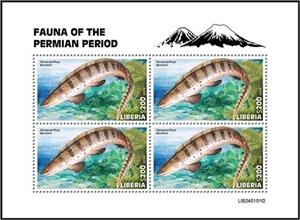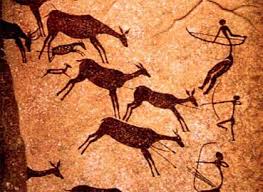Se-tenant: Xenacanthus decheni (Liberia 2024)
Xenacanthus decheni (Liberia 2024)
05 January (Liberia ) within release Permian Period Fauna (2024) goes into circulation Se-tenant Xenacanthus decheni face value 4*200 Liberian dollar
| Se-tenant Xenacanthus decheni in catalogues | |
|---|---|
| Colnect codes: | Col: LR 2024.01.05-148 |
Se-tenant is square format.
Also in the issue Permian Period Fauna (2024):
- Souvenir Sheet - Bellerophon jonessianus face value 1,200;
- Se-tenant - Diplocaulus salamandroides face value 4*200;
- Souvenir Sheet - Diplocaulus salamandroides face value 720;
- Mini Sheet - Fauna of the Permian Period face value 4*300;
- Souvenir Sheet - Lycaenops ornatus face value 1,200;
- Se-tenant - Pareiasaurus serridens face value 4*200;
- Souvenir Sheet - Pareiasaurus serridens face value 720;
- Se-tenant - Scutosaurus karpinskii face value 4*200;
- Souvenir Sheet - Scutosaurus karpinskii face value 720;
- Se-tenant - Xenacanthus decheni face value 4*200;
- Souvenir Sheet - Xenacanthus decheni face value 720;
|
Data entry completed
50%
|
|
|---|---|
| Se-tenant Xenacanthus decheni in digits | |
| Country: | Liberia |
| Date: | 2024-01-05 |
| Print: | Offset lithography |
| Emission: | Agency Issue |
| Format: | Se-tenant |
| Face Value: | 4*200 Liberian dollar |
Se-tenant Xenacanthus decheni it reflects the thematic directions:
Animals are multicellular, eukaryotic organisms of the kingdom Animalia (also called Metazoa). All animals are motile, meaning they can move spontaneously and independently, at some point in their lives. Their body plan eventually becomes fixed as they develop, although some undergo a process of metamorphosis later on in their lives. All animals are heterotrophs: they must ingest other organisms or their products for sustenance.
A fish is any member of a group of animals that consist of all gill-bearing aquatic craniate animals that lack limbs with digits. They form a sister group to the tunicates, together forming the olfactores. Included in this definition are the living hagfish, lampreys, and cartilaginous and bony fish as well as various extinct related groups. Tetrapods emerged within lobe-finned fishes, so cladistically they are fish as well. However, traditionally fish are rendered obsolete or paraphyletic by excluding the tetrapods (i.e., the amphibians, reptiles, birds and mammals which all descended from within the same ancestry). Because in this manner the term "fish" is defined negatively as a paraphyletic group, it is not considered a formal taxonomic grouping in systematic biology. The traditional term pisces (also ichthyes) is considered a typological, but not a phylogenetic classification. The earliest organisms that can be classified as fish were soft-bodied chordates that first appeared during the Cambrian period. Although they lacked a true spine, they possessed notochords which allowed them to be more agile than their invertebrate counterparts. Fish would continue to evolve through the Paleozoic era, diversifying into a wide variety of forms. Many fish of the Paleozoic developed external armor that protected them from predators. The first fish with jaws appeared in the Silurian period, after which many (such as sharks) became formidable marine predators rather than just the prey of arthropods. Most fish are ectothermic ("cold-blooded"), allowing their body temperatures to vary as ambient temperatures change, though some of the large active swimmers like white shark and tuna can hold a higher core temperature. Fish are abundant in most bodies of water. They can be found in nearly all aquatic environments, from high mountain streams (e.g., char and gudgeon) to the abyssal and even hadal depths of the deepest oceans (e.g., gulpers and anglerfish). With 33,100 described species, fish exhibit greater species diversity than any other group of vertebrates. Fish are an important resource for humans worldwide, especially as food. Commercial and subsistence fishers hunt fish in wild fisheries (see fishing) or farm them in ponds or in cages in the ocean (see aquaculture). They are also caught by recreational fishers, kept as pets, raised by fishkeepers, and exhibited in public aquaria. Fish have had a role in culture through the ages, serving as deities, religious symbols, and as the subjects of art, books and movies.
Prehistory, also called pre-literary history, is the period of human history between the first known use of stone tools by hominins c. 3.3 million years ago and the beginning of recorded history with the invention of writing systems. The use of symbols, marks, and images appears very early among humans, but the earliest known writing systems appeared c. 5,200 years ago. It took thousands of years for writing systems to be widely adopted, with writing spreading to almost all cultures by the 19th century. The end of prehistory therefore came at different times in different places, and the term is less often used in discussing societies where prehistory ended relatively recently.



